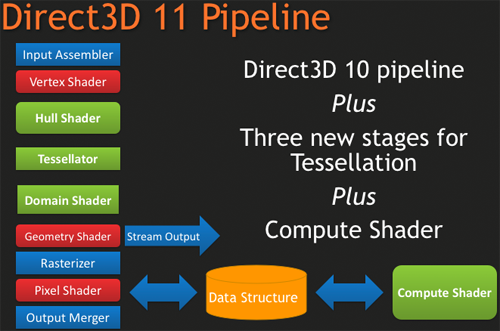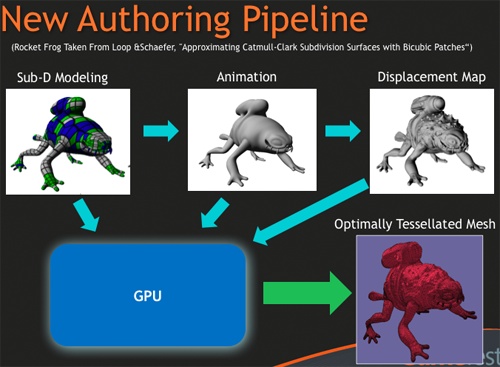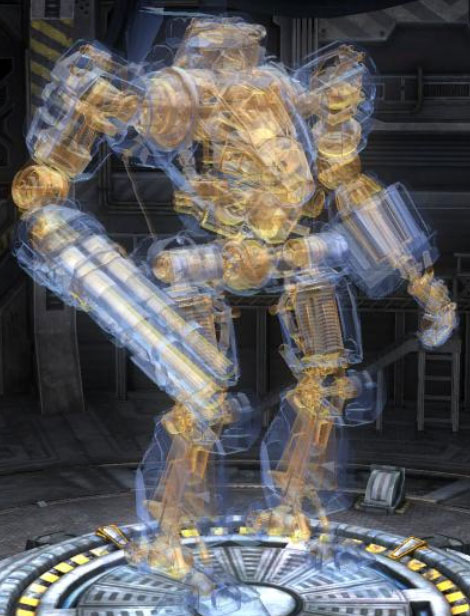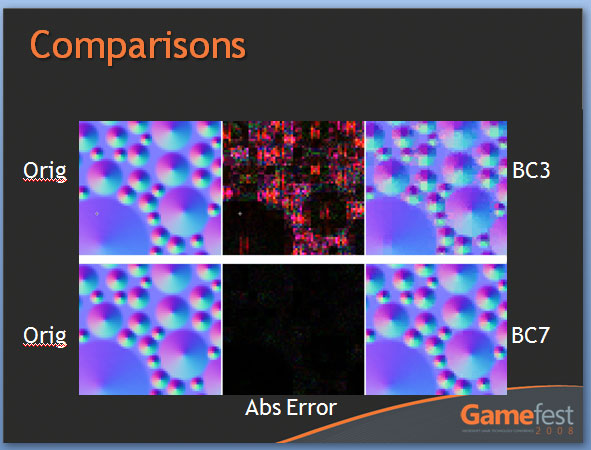AMD's Radeon HD 5870: Bringing About the Next Generation Of GPUs
by Ryan Smith on September 23, 2009 9:00 AM EST- Posted in
- GPUs
DirectX11 Redux
With the launch of the 5800 series, AMD is quite proud of the position they’re in. They have a DX11 card launching a month before DX11 is dropped on to consumers in the form of Win7, and the slower timing of NVIDIA means that AMD has had silicon ready far sooner. This puts AMD in the position of Cypress being the de facto hardware implementation of DX11, a situation that is helpful for the company in the long term as game development will need to begin on solely their hardware (and programmed against AMD’s advantages and quirks) until such a time that NVIDIA’s hardware is ready. This is not a position that AMD has enjoyed since 2002 with the Radeon 9700 and DirectX 9.0, as DirectX 10 was anchored by NVIDIA due in large part to AMD’s late hardware.
As we have already covered DirectX 11 in-depth with our first look at the standard nearly a year ago, this is going to be a recap of what DX11 is bringing to the table. If you’d like to get the entire inside story, please see our in-depth DirectX 11 article.
DirectX 11, as we have previously mentioned, is a pure superset of DirectX 10. Rather than being the massive overhaul of DirectX that DX10 was compared to DX9, DX11 builds off of DX10 without throwing away the old ways. The result of this is easy to see in the hardware of the 5870, where as features were added to the Direct3D pipeline, they were added to the RV770 pipeline in its transformation into Cypress.

New to the Direct3D pipeline for DirectX 11 is the tessellation system, which is divided up into 3 parts, and the Computer Shader. Starting at the very top of the tessellation stack, we have the Hull Shader. The Hull Shader is responsible for taking in patches and control points (tessellation directions), to prepare a piece of geometry to be tessellated.
Next up is the tesselator proper, which is a rather significant piece of fixed function hardware. The tesselator’s sole job is to take geometry and to break it up into more complex portions, in effect creating additional geometric detail from where there was none. As setting up geometry at the start of the graphics pipeline is comparatively expensive, this is a very cool hack to get more geometric detail out of an object without the need to fully deal with what amounts to “eye candy” polygons.
As the tesselator is not programmable, it simply tessellates whatever it is fed. This is what makes the Hull Shader so important, as it’s serves as the programmable input side of the tesselator.
Once the tesselator is done, it hands its work off to the Domain Shader, along with the Hull Shader handing off its original inputs to the Domain Shader too. The Domain Shader is responsible for any further manipulations of the tessellated data that need to be made such as applying displacement maps, before passing it along to other parts of the GPU.

The tesselator is very much AMD’s baby in DX11. They’ve been playing with tesselators as early as 2001, only for them to never gain traction on the PC. The tesselator has seen use in the Xbox 360 where the AMD-designed Xenos GPU has one (albeit much simpler than DX11’s), but when that same tesselator was brought over and put in the R600 and successive hardware, it was never used since it was not a part of the DirectX standard. Now that tessellation is finally part of that standard, we should expect to see it picked up and used by a large number of developers. For AMD, it’s vindication for all the work they’ve put into tessellation over the years.
The other big addition to the Direct3D pipeline is the Compute Shader, which allows for programs to access the hardware of a GPU and treat it like a regular data processor rather than a graphical rendering processor. The Compute Shader is open for use by games and non-games alike, although when it’s used outside of the Direct3D pipeline it’s usually referred to as DirectCompute rather than the Compute Shader.
For its use in games, the big thing AMD is pushing right now is Order Independent Transparency, which uses the Compute Shader to sort transparent textures in a single pass so that they are rendered in the correct order. This isn’t something that was previously impossible using other methods (e.g. pixel shaders), but using the Compute Shader is much faster.

Other features finding their way into Direct3D include some significant changes for textures, in the name of improving image quality. Texture sizes are being bumped up to 16K x 16K (that’s a 256MP texture) which for all practical purposes means that textures can be of an unlimited size given that you’ll run out of video memory before being able to utilize such a large texture.
The other change to textures is the addition of two new texture compression schemes, BC6H and BC7. These new texture compression schemes are another one of AMD’s pet projects, as they are the ones to develop them and push for their inclusion in DX11. BC6H is the first texture compression method dedicated for use in compressing HDR textures, which previously compressed very poorly using even less-lossy schemes like BC3/DXT5. It can compress textures at a lossy 6:1 ratio. Meanwhile BC7 is for use with regular textures, and is billed as a replacement for BC3/DXT5. It has the same 3:1 compression ratio for RGB textures.
We’re actually rather excited about these new texture compression schemes, as better ways to compress textures directly leads to better texture quality. Compressing HDR textures allows for larger/better textures due to the space saved, and using BC7 in place of BC3 is an outright quality improvement in the same amount of space, given an appropriate texture. Better compression and tessellation stand to be the biggest benefactors towards improving the base image quality of games by leading to better textures and better geometry.
We had been hoping to supply some examples of these new texture compression methods in action with real textures, but we have not been able to secure the necessary samples in time. In the meantime we have Microsoft’s examples from GameFest 2008, which drive the point home well enough in spite of being synthetic.

Moving beyond the Direct3D pipeline, the next big feature coming in DirectX 11 is better support for multithreading. By allowing multiple threads to simultaneously create resources, manage states, and issue draw commands, it will no longer be necessary to have a single thread do all of this heavy lifting. As this is an optimization focused on better utilizing the CPU, it stands that graphics performance in GPU-limited situations stands to gain little. Rather this is going to help the CPU in CPU-limited situations better utilize the graphics hardware. Technically this feature does not require DX11 hardware support (it’s a high-level construct available for use with DX10/10.1 cards too) but it’s still a significant technology being introduced with DX11.
Last but not least, DX11 is bringing with it High Level Shader Language 5.0, which in turn is bringing several new instructions that are primarily focused on speeding up common tasks, and some new features that make it more C-like. Classes and interfaces will make an appearance here, which will make shader code development easier by allowing for easier segmentation of code. This will go hand-in-hand with dynamic shader linkage, which helps to clean up code by only linking in shader code suitable for the target device, taking the management of that task out of the hands of the coder.










327 Comments
View All Comments
maomao0000 - Sunday, October 11, 2009 - link
http://www.myyshop.com">http://www.myyshop.comQuality is our Dignity; Service is our Lift.
Myyshop.com commodity is credit guarantee, you can rest assured of purchase, myyshop will
provide service for you all, welcome to myyshop.com
Air Jordan 7 Retro Size 10 Blk/Red Raptor - $34
100% Authentic Brand New in Box DS Air Jordan 7 Retro Raptor colorway
Never Worn, only been tried on the day I bought them back in 2002
$35Firm; no trades
http://www.myyshop.com/productlist.asp?id=s14">http://www.myyshop.com/productlist.asp?id=s14 (Jordan)
http://www.myyshop.com/productlist.asp?id=s29">http://www.myyshop.com/productlist.asp?id=s29 (Nike shox)
shaolin95 - Wednesday, October 7, 2009 - link
So Eyefinity may use 100 monitors but if we are still gaming on the flat plant then it makes no difference to me.Come on ATI, go with the real 3D games already..been waiting since the Radeon 64 SE days for you to get on with it.... :-(
GTX 295 for this boy as it is the only way to real 3D on a 60" DLP.
Nice that they have a fast product at good prices to keep the competition going. If either company goes down we all lose so support them both! :-)
Regards
raptorrage - Tuesday, October 6, 2009 - link
wow what a joke this review is but that i mean the reviewer stance on the 5870 sounds like he is a nvidia fan just because it like what 2-3fps off of the gtx 295 doesn't actually mean it can't catch that gpu as the driver updates come out and get the gpu to actually compete against that gpu and if i remember wasn't the GTX 295 the same when it came out .. its was good but it wasn't where we all thought it should have been then BAM a few months go by and it finds the performance it was missingi don't know if this was a fail on anandtech or the testing practices but i question them as i've read many other review sites and they had a clear view where the 5870 / GTX 295 where neck N neck as i've seen them first hand so i go ahead and state them here head 2 head @ 1920x1200 but at 2560x1600 the dual gpu cards do take the top slot but that is expected but it isn't as big as a margin as i see it.
and clearly he missed the whole point YES the 5870 dose compete with the GTX 295 i just believe your testing practices do come into question here because i've seen many sites where they didn't form the opinion that you have here it seems completely dismissive like AMD has failed i just don't see that in my opinion - I'll just take this review with a gain of salt as its completely meaningless
dieselcat18 - Saturday, October 3, 2009 - link
@Silicon DocNvidia fan-boy, troll, loser....take your gforce cards and go home...we can now all see how terrible ATi is thanks you ...so I really don't understand why people are beating down their doors for the 5800 series, just like people did for the 4800 and 3800 cards. I guess Nvidia fan-boy trolls like you have only one thing left to do and that's complain and cry like the itty-bitty babies that some of you are about the competition that's beating you like a drum.....so you just wait for your 300 series cards to be released (can't wait to see how many of those are available) so you can pay the overpriced premiums that Nvidia will be charging AGAIN !...hahaha...just like all that re-badging BS they pulled with the 9800 and 200 cards...what a joke !.. Oh my, I must say you have me in a mood and the ironic thing is I do like Nvidia as much as ATi, I currently own and use both. I just can't stand fools like you who spout nothing but mindless crap while waving your team flag (my card is better than your's..WhaaWhaaWhaa)...just take yourself along with your worthless opinions and slide back under that slimly rock you came from.
dieselcat18 - Saturday, October 3, 2009 - link
@Silicon DocNvidia fan-boy, troll, loser....take your gforce cards and go home...we can now all see how terrible ATi is thanks you ...so I really don't understand why people are beating down their doors for the 5800 series, just like people did for the 4800 and 3800 cards. I guess Nvidia fan-boy trolls like you have only one thing left to do and that's complain and cry like the itty-bitty babies that some of you are about the competition that's beating you like a drum.....so you just wait for your 300 series cards to be released (can't wait to see how many of those are available) so you can pay the overpriced premiums that Nvidia will be charging AGAIN !...hahaha...just like all that re-badging BS they pulled with the 9800 and 200 cards...what a joke !.. Oh my, I must say you have me in a mood and the ironic thing is I do like Nvidia as much as ATi, I currently own and use both. I just can't stand fools like you who spout nothing but mindless crap while waving your team flag (my card is better than your's..WhaaWhaaWhaa)...just take yourself along with your worthless opinions and slide back under that slimly rock you came from.
Scali - Thursday, October 1, 2009 - link
I have the GPU Computing SDK aswell, and I ran the Ocean test on my 8800GTS320. I got 40 fps, with the card at stock, with 4xAA and 16xAF on. Fullscreen or windowed didn't matter.How can your score be only 47 fps on the GTX285? And why does the screenshot say 157 fps on a GTX280?
157 fps is more along the lines of what I'd expect than 47 fps, given the performance of my 8800GTS.
Ryan Smith - Thursday, October 1, 2009 - link
Full screen, 2560x1600 with everything cranked up. At that resolution, it can be a very rough benchmark.The screenshot you're seeing is just something we took in windowed mode with the resolution turned way down so that we could fit a full-sized screenshot of the program in to our document engine.
Scali - Friday, October 2, 2009 - link
I've just checked the sourcecode and experimented a bit with changing some constants.The CS part always uses a dimension of 512, hardcoded, so not related to the screen size.
So the CS load is constant, the larger you make the window, the less you measure the GPGPU-performance, since it will become graphics-limited.
Technically you should make the window as small as possible to get a decent GPGPU-benchmark, not as large as possible.
Scali - Friday, October 2, 2009 - link
Hum, I wonder what you're measuring though.I'd have to study the code, see if higher resolutions increase only the onscreen polycount, or also the GPGPU-part of generating it.
Scali - Thursday, October 1, 2009 - link
That's 152 fps, not 257, sorry.